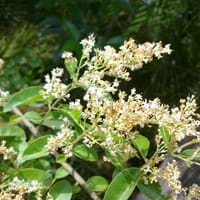Life Span
Perennial
Perennial
Type
Perennial
Broadleaf Evergreen
Types
Not Available
Ligustrum sinense concavum, Ligustrum sinense coryanum, Ligustrum sinense dissimile
Number of Varieties
Not Available
Habitat
Chaparral, River side
Not Available
USDA Hardiness Zone
7-10
8-10
AHS Heat Zone
9-1
Not Available
Sunset Zone
H1, 4, 5, 6, 7, 8, 9, 10, 11, 12, 14, 15, 16, 17, 18, 19, 20, 21, 22, 23, 24
21,22
Habit
Upright/Erect
Upright/Erect
Minimum Width
Not Available
Flower Color
White, Yellow
White
Flower Color Modifier
Bicolor
Bicolor
Fruit Color
Green, Tan
Dark Blue, Black
Leaf Color in Spring
Gray Green
Dark Green
Leaf Color in Summer
Gray Green
Dark Green
Leaf Color in Fall
Gray Green
Dark Green
Leaf Color in Winter
Light Green
Dark Green
Leaf Shape
Lance shaped
Ovate
Plant Season
Spring, Summer
Spring, Summer, Fall, Winter
Sunlight
Full Sun
Full Sun, Partial Sun, Partial shade
Growth Rate
Fast
Very Fast
Type of Soil
Loam, Sand
Loam, Sand
The pH of Soil
Neutral, Alkaline
Acidic, Neutral, Alkaline
Soil Drainage
Well drained
Average
Bloom Time
Early Spring, Spring, Late Spring, Early Summer, Summer
Summer
Tolerances
Drought
Pollution, Drought, Salt
Where to Plant?
Ground
Ground
How to Plant?
Cuttings, Seedlings
Cuttings
Plant Maintenance
Medium
Medium
Watering Requirements
Needs watering once a week, Water well when planted
Keep the ground moist but not water-logged
In Summer
Lots of watering
Lots of watering
In Spring
Moderate
Moderate
In Winter
Average Water
Average Water
Soil pH
Neutral, Alkaline
Acidic, Neutral, Alkaline
Soil Type
Loam, Sand
Loam, Sand
Soil Drainage Capacity
Well drained
Average
Sun Exposure
Full Sun
Full Sun, Partial Sun, Partial shade
Pruning
prune nearly to the ground in late fall
Prune in spring
Fertilizers
organic fertlizers
Fertilize just before the growing season begins
Pests and Diseases
Verticillium Wilt
Not Available
Plant Tolerance
Drought
Drought, Pollution, Salt
Flower Petal Number
Single
Single
Showy Foliage
Not Available
Yes
Foliage Texture
Not Available
Medium
Foliage Sheen
Not Available
Glossy
Attracts
Bees, Birds, Butterflies
Birds
Allergy
no allergic reactions
Not Available
Aesthetic Uses
Showy Purposes
Showy Purposes, small hedge
Beauty Benefits
Not Available
Not Available
Environmental Uses
Air purification
Air purification
Medicinal Uses
antimicrobial, Astringent, Gum Problems, Stomach pain
Not Available
Part of Plant Used
Flower Stalk
Whole plant
Other Uses
Used as Ornamental plant
Used as Ornamental plant
Used As Indoor Plant
No
No
Used As Outdoor Plant
Yes
Yes
Garden Design
Feature Plant, Groundcover, Mixed Border, Wildflower
Feature Plant, Hedges, Screening, Wind Break, Street Trees
Botanical Name
ROMNEYA coulteri
Ligustrum sinense
Common Name
Matilija Poppy
Chinese privet
In Hindi
Matilija Poppy
Chinese privet
In German
Matilija Poppy
Chinesischer Liguster
In French
Matilija Poppy
Chinese privet
In Spanish
Matilija amapola
aligustrina, ligustrina, ligustrín, o aligustre
In Greek
Matilija παπαρούνας
Κινέζοι privet
In Portuguese
Matilija Poppy
Ligustrina
In Polish
Matilija Poppy
Chiński ligustr
In Latin
Matilija Poppy
Chinese privet
Phylum
Magnoliophyta
Magnoliophyta
Class
Magnoliopsida
Magnoliopsida
Order
Papaverales
Scrophulariales
Family
Papaveraceae
Oleaceae
Clade
Angiosperms, Eudicots
Angiosperms, Asterids, Eudicots
Tribe
Not Available
Oleeae
Subfamily
Papaveroideae
Not Available
Properties of Matilija Poppy and Chinese Privet
Wondering what are the properties of Matilija Poppy and Chinese Privet? We provide you with everything About Matilija Poppy and Chinese Privet. Matilija Poppy has thorns and Chinese Privet doesn't have thorns. Also Matilija Poppy does not have fragrant flowers. Matilija Poppy has allergic reactions like no allergic reactions and Chinese Privet has allergic reactions like no allergic reactions. Compare all the properties and characteristics of these two plants. Find out which of these plant can be used as indoor plant. If you are interested to decorate your house and garden, find out aesthetic uses, compare them and select the plant which will beautify your surrounding. Along with beautification, try comparing medicinal and edible uses of Matilija Poppy and Chinese Privet and you can choose the plant having best and most benefits.
Season and Care of Matilija Poppy and Chinese Privet
Season and care of Matilija Poppy and Chinese Privet is important to know. While considering everything about Matilija Poppy and Chinese Privet Care, growing season is an essential factor. Matilija Poppy season is Spring and Summer and Chinese Privet season is Spring and Summer. The type of soil for Matilija Poppy is Loam, Sand and for Chinese Privet is Loam, Sand while the PH of soil for Matilija Poppy is Neutral, Alkaline and for Chinese Privet is Acidic, Neutral, Alkaline.
Matilija Poppy and Chinese Privet Physical Information
Matilija Poppy and Chinese Privet physical information is very important for comparison. Matilija Poppy height is 120.00 cm and width Not Available whereas Chinese Privet height is 460.00 cm and width 300.00 cm. The color specification of Matilija Poppy and Chinese Privet are as follows:
Matilija Poppy flower color: White and Yellow
Matilija Poppy leaf color: Gray Green
Chinese Privet flower color: White
- Chinese Privet leaf color: Dark Green
Care of Matilija Poppy and Chinese Privet
Care of Matilija Poppy and Chinese Privet include pruning, fertilizers, watering etc. Matilija Poppy pruning is done prune nearly to the ground in late fall and Chinese Privet pruning is done Prune in spring. In summer Matilija Poppy needs Lots of watering and in winter, it needs Average Water. Whereas, in summer Chinese Privet needs Lots of watering and in winter, it needs Average Water.





